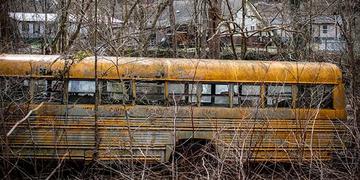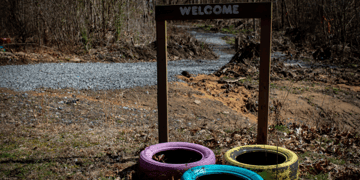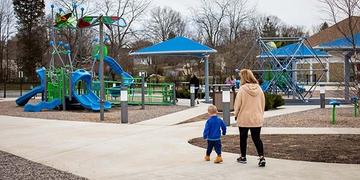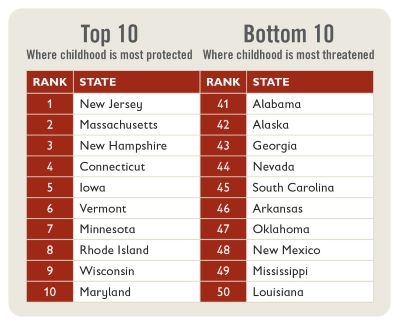
An abandoned school bus in McDowell County, West Virginia. McDowell is the state’s poorest county, with 43% of children growing up in poverty.
When High School–and Childhood–Is Cut Short in America
Where a child grows up can determine their prospects in life more than you might guess. Children who grow up in areas without access to early education, for example, are more likely to drop out of high school, become a teen parent, never attend college and be arrested for a violent crime – perpetuating the cycle of poverty.
In McDowell Country in West Virginia, the state’s poorest county, 17% of children are not graduating from high school on time. Surrounded by the Appalachians, McDowell is the Mountain State’s southernmost county, and it’s also the state’s lowest ranked county for children, according to the analysis in 91�ֿ�’s 2020 U.S. Complement to the Global Childhood Report.
Examining data from more than 2,600 counties and county-equivalents in all 50 states, the 2020 U.S. Complement to the Global Childhood Report includes a first-ever ranking of counties where children are most and least prioritized and protected. The rankings are based on four factors that cut childhood short, including poor education. In the bottom-ranked counties—places like McDowell County, WV—children are up to 14 times as likely to drop out of high school as children in the best counties in their state.

A play area in McDowell County, West Virginia stands in stark contrast to play spaces in Putnam County, just 100 miles away.
A Tale of Two Counties in West Virginia
A once thriving coal industry has experienced a sharp decline in the past 15 years, leaving few job opportunities in McDowell County. The schools, a local prison and the state highway department are now among the county’s largest employers.
Many kids grapple with hunger – 28% experience food insecurity. One in every 6 students in the county are not graduating high school on time, and 1 in 21 girls aged 15 to 19 give birth each year – one of the highest teen birth rates in the state.
Putnam County, about 100 miles away, is the best ranked county in the state for children. Compared to Putnam, children in McDowell County are twice as likely to struggle with hunger and not graduate on time, and nearly 3 times as likely to not survive childhood. Adolescent girls are 4 times as likely to have a baby.
With the isolation of the surrounding mountains, the dwindling jobs and the steady loss of business, children and families in McDowell County also lack access to critical services. Parents seeking developmental support and testing for their children – including genetic and autism assessments – need to travel up to two hours or more for such services.

Parents and children enjoy a well-equipped playground in Putnam County, West Virginia.
The state’s highest ranked county for children, Putnam, is the second wealthiest in the state, with a median household income more than double that of McDowell County. Its more accessible location and greater family resources are major factors giving children a good chance to reach their full potential. Community leaders say nearly any chosen career path is possible for Putnam County’s kids. As children grow and begin to turn an eye toward their futures, there are at least three universities within a 30-minute drive.
McDowell and Putnam Counties are just two examples of the unacceptable reality in America, where one child can be exponentially more likely than another to succeed in life based solely on where they grow up.

County-Level Findings on High School Drop Out Rates in America
Over 9 million children live in the lowest-ranked counties (bottom 25%), and they are facing huge challenges to growing up safe and secure.
Nationwide, 15% of high school students failed to graduate on time during the 2016-2017 school year. Iowa had the lowest percentage of students not graduating on time, with a rate of 9%, closely followed by New Jersey at 9.5%.
The states with the highest percentage of students not graduating on time were New Mexico (28.9%) and Oregon (23.3%).
On-time graduation rates are lowest in Wheeler County, Oregon, where 74% of children fail to complete high school on time. Compared to Page County, Virginia – where only 0.4% of students fail to graduate on time – children in Wheeler County are 185 times more likely to miss out on education. Dozens of counties across 14 states reportedly have on-time graduation rates of 100% (although almost all of them are less-populous rural areas with small numbers of children).
Six counties have on-time graduation rates at or below 50%, meaning most kids in these counties do not do well in school. These counties are Inyo (California), Madison (Louisiana), Mono (California), Nevada (California), Treasure (Montana) and Wheeler (Oregon).
Solutions to “Get Kids Across the Finish line”
Tucked in the southwest corner of Tennessee – its western border carved by the Mississippi River – is Lauderdale County. It’s a county filled with small-town charm and hospitality, despite high levels of unemployment and limited job opportunities due to factory closures, shifts in industry and major infrastructure and transportation challenges. With a child poverty rate of 35%, 1 in 3 kids are growing up impoverished, yet children in Lauderdale County are succeeding – the county is among the nation’s top counties for on-time high school graduation.
However, it wasn’t always this way. A decade ago, the county’s high school graduation rate was an alarming 70%, meaning 1 in 3 children were not earning their diploma or an equivalent, such as a GED. County leaders were concerned, so they developed innovative solutions to “get kids across the finish line,” according to Superintendent Shawn Kimble.
Superintendent Kimble underscored the county’s commitment to preventing children’s life challenges from triggering school dropouts. They embrace flexibility while working with students to complete the required credits. “As a district,” he says, “our main goal is to remove barriers for students to be successful.
The Impact of COVID-19 on Learning Loss in America
No one could have predicted the barrier that COVID-19 would present to students across America. Nearly 94% of America’s schools were forced to close their doors due to coronavirus concerns. With such an unprecedented number of school closures taking kids out of the classroom, some experts fear many may never return. Those children living in poverty are even more at risk of learning loss.
The poorest children tend to have the fewest learning materials at home. And millions, especially in rural areas, lack high-speed internet and the digital devices necessary for distance learning.
That’s why 91�ֿ� has been working since the start of the pandemic to ensure learning continues. We know the earliest years are the most important for a child’s development.
We are also calling on policymakers at all levels of government to robustly support the welfare and development of all children, regardless of where they reside.
Early Investments Can lead to Higher High School Graduation Rates
High-quality early childhood programs are a great investment and actually help save taxpayers’ money in the long run. A recent report from Nobel Prize-winning economist
James Heckman shows the return on investment for early childhood development for disadvantaged children can be 13% per child, per year, due to improved outcomes in education, health and economic productivity. Children who have participated in a high-quality early education program often earn higher incomes, are more likely to graduate from high school and are less likely to be arrested for a violent crime.
Creating a more successful generation of children will benefit the nation as a whole for decades to come. Today’s children are tomorrow’s engineers, teachers and business leaders. We often hear leaders complain about the debt we are leaving for our children and grandchildren. Why not invest in them so we make sure they are better off?
We know this change is possible. Together, we can ensure every last child has the childhood – and future –they deserve.
